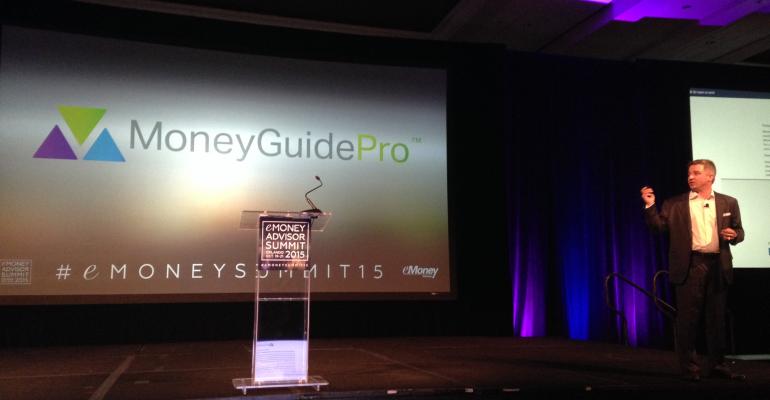The two biggest names in financial planning software are now partners.
During a Wednesday session at the eMoney Advisor Summit in Orlando, Fla., MoneyGuidePro President Kevin Knull announced that his goals-based financial planning engine would integrate with eMoney Advisor’s emX Select wealth management dashboard. The integration brings MoneyGuidePro’s retirement, health care, Social Security, estate and college planning tools, as well as its asset allocation and insurance analysis features to eMoney, letting advisors access both financial planning tools from a single digital portal.
The two may seem like strange bedfellows to those who watched them angle for control over the financial planning software market for 15 years. But Michael Durbin, president of Fidelity Wealth Technologies and interim CEO of eMoney Advisor following Edmond Walters’ resignation in September, said the companies are more complementary than competitive.
“There is a difference in the core flavor of planning,” Durbin said, noting that MoneyGuidePro’s focus on goals-based planning while eMoney is optimized for cash flow-based planning. “But with eMoney, we’re trying to change the relationship that an advisor can have with their heads of household over time by really helping them digitize their practice and have a very, very efficient approach to managing those relationships.”
In other words, while MoneyGuidePro continues a singular focus on goals-based financial planning, eMoney is focusing on emX Select, the one-stop toolbox where advisors can access the full kit of their wealth management software (CRM, performance reporting, risk tolerance, etc.). With different value propositions, the companies no longer see themselves as competitors.
The elephant in the room is Fidelity, which acquired eMoney in February. At the time, advisors who didn’t custody with Fidelity worried they might lose access to eMoney, or that account information at other custodians would be shared. This new partnership could introduce similar concerns among MoneyGuidePro users.
Fidelity has maintained since the acquisition that eMoney will remain an independent software company, and Durbin said Tuesday that the integration between eMoney and MoneyGuidePro is independent of Fidelity.
“We want to deploy eMoney inside the right channels of Fidelity [over] time,” Durbin said. “As eMoney continues to innovate on its platform and strike these great third party relationships, all of that functionality is available to any licensee, Fidelity or otherwise.”
Durbin said the integration is ultimately a continuation of the trend of third party integrations the eMoney has announced over the last year.
Joel Bruckenstein, the producer of the Technology Tools for Today conferences, said the integration was hardly surprising given the relationship the two companies have had with Suntrust Bank since 2014. Many of the financial services firms he consults use both products and are looking forward to only needing one portal.
“If advisors want the best of both worlds and its profitable for both companies to do that; why not give it to them?” Bruckenstein said.
Others see the integration as a big move by Fidelity to differentiate itself from other custodians. According to Timothy Welsh, the president and founder of Nexus Strategy, there is a technology arms race to control the advisor desktop, and a partnership between eMoney and MoneyGuidePro gives Fidelity a hold on the financial planning market that other custodians can’t offer.
“Fidelity is in an interesting position,” Welsh said. “They own the software platform that is used by a lot of different advisors that have assets custodied elsewhere.”
He added the eMX’s unbundling strategy – letting advisors choose from a menu of third party options – is a new direction for Fidelity, which traditionally offered advisors a prepackaged set of technology with WealthCentral. When Fidelity acquired eMoney, Ed O’Brien, Fidelity’s senior vice president of technology platforms, said the purchase would help accelerate the plan to expand WealthCentral, but the company did not comment if this latest integration was a part of that strategy.
While the move towards partnerships is one avenue of attack to control the advisor desktop, it contrasts with those of other custodians. TD Ameritrade’s open-API Veo One platform seems to have fully embraced the unbundling method, while Envestnet is sticking with the acquisition model. Fidelity seems to be taking a middle path.
“The end game is to own the software that runs your business,” Welsh said. “If I’m a custodian or an asset manager or a TAMP; if I own your software then pretty much you’re going to come to my store for me to see your mutual funds.
“To me, this is the first step. We’re just going to start here, but then it’s only a matter of time before [Fidelity] takes another step in terms of acquiring software.”
Durbin rejected the idea Fidelity was interested buying MoneyGuidePro, saying it could ultimately work against a product intended for independent advisors looking for an open-architecture desktop where they can pick the software that works best for them.
“The right solution is not to acquire components to put on our own proprietary string of pearls, but find those pearls that seem to be resonating with the kinds of clients that we want on our platform long-term, and integrate with them.”
He added that while eMX will be an unbundled experience, they don’t tend to integrate with every CRM system or every planning engine. They instead would like to focus on two or three partners for each function, and the addition of MoneyGuidePro gives advisors that second option for financial planning.
Bruckenstein said that in the end, he hoped partnerships like this would encourage other companies to be more open to working together.
“You can be, in certain areas, competing with somebody and, in other areas, co-operating with them and actually partnering with them,” Bruckenstein said. “And if it makes sense for all parties and benefits everybody including the advisor, I’m all for it.”


